You may not find this terribly rewarding unless you're included here, so this is a good time for casual and random browsers to turn back before they get too caught up in the sweep and majesty of the proceedings and can't let go.
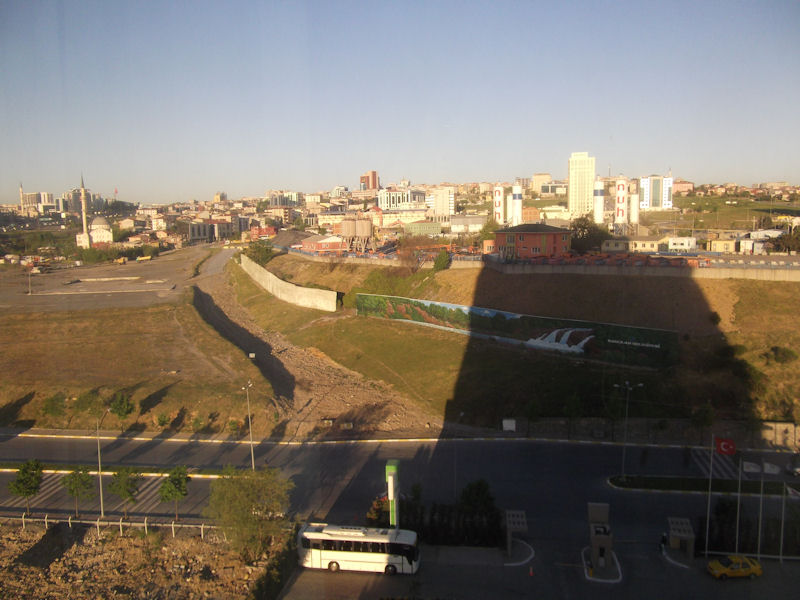
But with next to no European flights to Georgia, we're overnighting through Istanbul and taking an extra day to go downtown and see the Istanbul Big Three. This is our late afternoon first of May view from out the Holiday Inn Airport.

The Big Three: first, the Blue Mosque, of course. Then the Hagia Sophia, and then Topkapi Palace, and the rest is for people with time on their hands.

We leapt off the hotel shuttle bus at Sultanahmed square, the downtown taxi point, and were approached by a loquacious young Kurdish gentleman who advised us about the best way to get into the Blue Mosque without all the tourist lines.

Lovely façades, and very nice rain gutters off the roof, but without gargoyles on them. Not very Blue, though. The young Kurdish gentleman, who spoke eighty languages and had lived in the USA, assured us that he was not a tour guide but would just point us in the right direction -- but after pointing us in the right direction, he came along anyway, and recounted most of his life story. And mentioned that he and his four brothers had a rug shop in the bazaar, and he'd be very pleased to show it to us.

Our not-a-tour-guide, just-a-simple-rug-merchant (left) is leading us round to the back entrance, all perfectly legal (as long as you get your shoes off before going in. That's some kind of Muslim thing, no shoes. Like pork.)

Our rug merchant who is not a tour guide and doesn't want any money explained the significance of some of the striking stained glass windows.

It all seems very nice and would probably repay half an hour's wandering round and gawking, if the crowds were not jostling and our not-a-tour-guide were not so anxious to show us his four older brothers' carpet shop.

Presumably they still do a lot of religion here, so they must have to clear out all the crowds from time to time. In fact, probably five times a day, starting with the dawn call from the muezzin or a recording.

It's big, and it's pretty. A coffeetable book about the place would probably make a much more nuanced impression on us.

A photo taken at the insistence of our not-a-tour-guide. We look like people who would step off a hotel shuttle bus and buy a 2,000 dollar carpet because 'oh why not'.

Like Christian steeples, always reaching for Heaven. Or, at least, Upwards.

"Please do not sit here." Thousands of tourists per hour walk out of the place with their shoes in a plastic bag -- Don't sit here!!! It's like going through those airport security lines where the overweight TSA people make you take off your shoes and belt to go through and then try to hurry you off the other side promptly still in your socks and holding your trousers up.


Shoes on, following our not-a-tour-guide, doesn't-want-any-money as we dash onward to the bazaar.

"Forbi Den" is Turkish for "one warning shot, that's all".

Kristin is explaining that, in fact, we haven't come to buy a rug, carpet, or kilim, but our not-a-tour-guide would just like to show us his family's shop, if we don't mind. Just to see it. And meet some of his five brothers and four sisters, all from Kurdistan, who had to leave there when the Turks obliterated the separatist region (so to flee the Turks they came to . . . Istanbul).
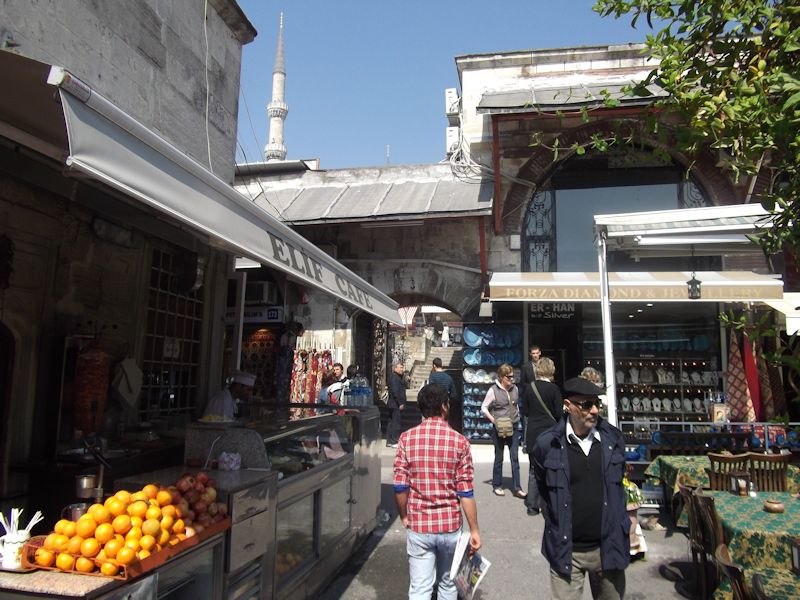
So we went along anyway, and Kristin enjoyed discussing the high-quality carpet types and techniques and designs, since she knows the subject well. But then it turned out that, even after coffee and tea as part of the traditional Kurdish and/or Turkish hospitality, we really didn't want to buy a rug -- sorry, a "piece of art" -- and things began to get acrimonious. All that time invested in us, and at the end of it, we still did not want to buy a $2000 rug. Even after the tea!

The shop employs 280 "girls" in the Lake Van region, spending a year or two on each carpet, and who would have guessed that we seem to have thrown a couple of them out of work and condemned them to starvation?

Buy your rugs here. And sunglasses.
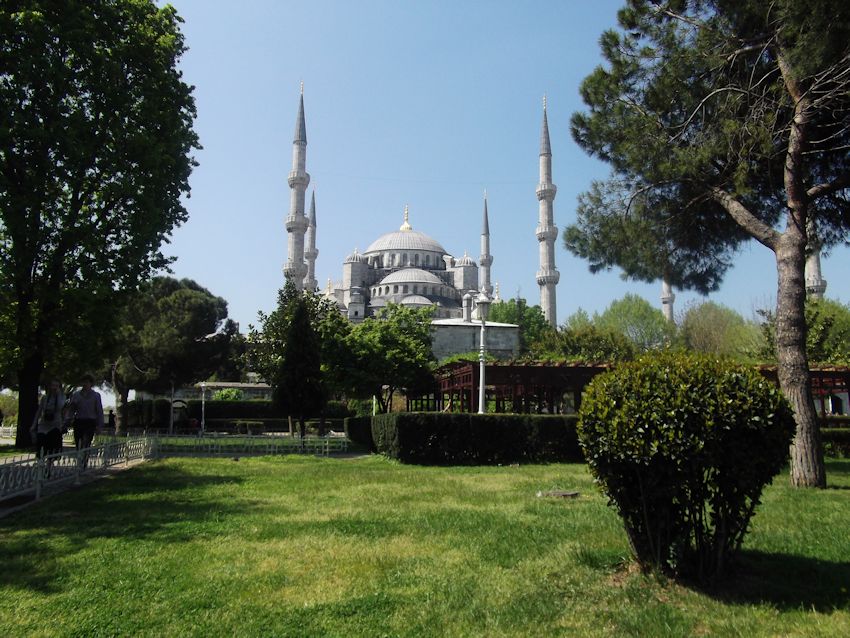
So, back to the Blue Mosque. Impressive -- properly, the Sultan Ahmed Mosque, built by Mr Ahmed in the early 17th century in order to placate an angry Allah after a long series of military disasters against the Persians. The old Byzantine emperors' palace is underneath it somewhere.

Not very Blue, is it? That's got to do with tiles inside, we're told: "The upper levels of the interior are dominated by blue paint, but it is of poor quality." (Wikipedia)

It has a pleasing squatty roundy shape to it.
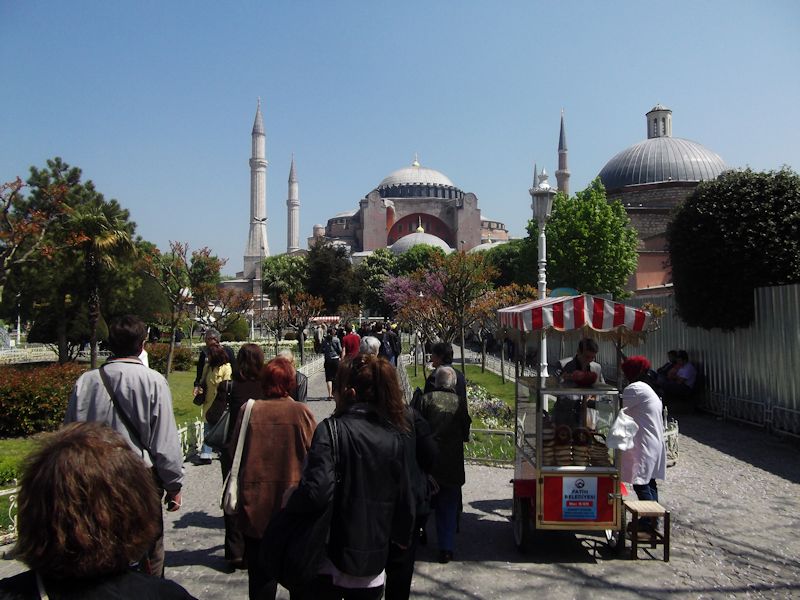
But we're headed for the Hagia Sophia now. I'm dying for a pretzel, but Kristin says we want a real lunch.

The Hagia Sophia, or Holy Wisdom church was built in 360 as the Christian cathedral of Constantinople and served as a religious centre of the Byzantine Empire until the Muslims, after 800 years of trying, finally overran Byzantium in 1453. And promptly mosquized it (plastering over the mosaics, etc.)

Hagia Sophia, secularized in 1935 and turned into a museum, really looks kind of crappy to me -- but it was sufficient in its time to bring shock and awe into the hearts of the Frankish crusaders when they showed up in 1096 and '97, ready to kick everybody's butt, and after seeing the sophisticated grandeur of this place (perhaps freshly painted) they agreed to take their orders from the emperor Alexios I Comnenus on the First Crusade (but reneged).

A tourist

Front doors to the Hagia Sophia (across from the outdoor restaurant), with a look of the Roman colisseum about it

A very big central place, like a European central train station with a lot of make-up on, not seen at its best with a point-and-shoot Fuji.

It's pretty impressive, in a cathedral sort of way, but the Muslim conquerors have tarted it up quite a bit.

This is the upstairs gallery ("up-ramp gallery" actually), very spacious.
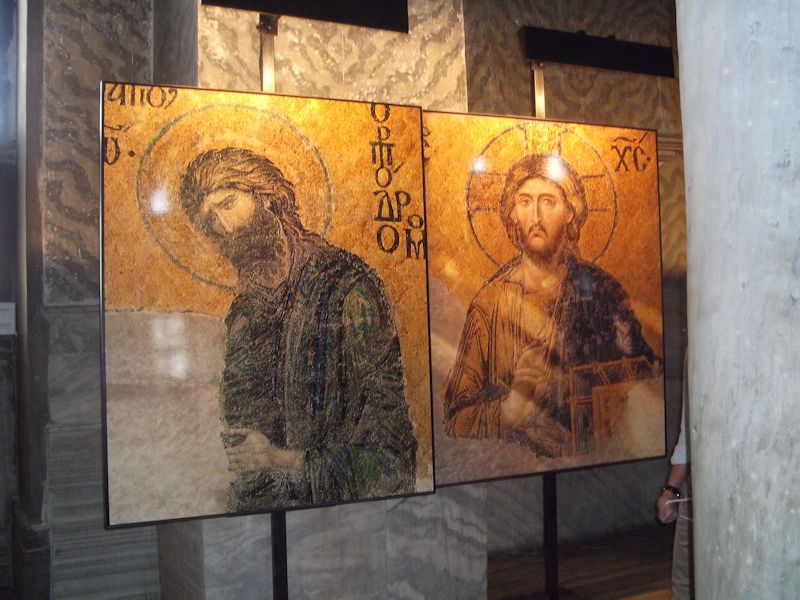
Early Muslims. Errrm.

Okay. Two of the Big Istanbul Three down. We won't have time for the Bosphorus boat cruise, that's certain now.

We're headed for box three to tick off, Topkapi Palace.

"This Part is Just For Pray to Muslim". Tourists round to the back entrance.

The Sultanahmed taxi stop side of the Hagia Sophia church (sorry, mosque)

Sultanahmed square, looking at the Blue Mosque and Hagia Sophia, with Topkapi gardens behind us. The pretzels look good.

We're inside the gardens precinct leading to Topkapi, but what we really want to see are the Archaeological Museums, which are said to be fantastic.

They're just down this street off to the side.

They are fantastic, as predicted. This is the museum of Really Old Mesopotamian stuff -- Sumerian, Akkadian, Assyrian, you name it.

Ishtar Gate quality stuff from Babylon -- in fact, like this. Ishtar gate stuff is spread all over the world but this is said to be the best bunch of it.

I took nearly 2,600 photographs, but since no flash was permitted in the museum most of them didn't come out very well.

Ishtar Gate stuff

Who hasn't had days like this? This was once a Mesopotamian Super-King, very arrogant, used to throw his weight around and make everybody fearful. Now look at him. Ha ha ha. ("My name is Ozymandias, King of Kings: /
Look on my works, ye mighty, and despair!")

Another museum in the same complex -- this one has got the famous Sidonian Necropolis. What a story hangs on that thread.

I'm sure I've seen many of these reliefs in books for years, but I had never heard of the Necropolis of Sidon per se, from the Phoenician city. These tombs and sarcophagi are many and varied, spanning centuries.

The central hall has an elaborate exhibition on Osman Hamdi Bey, the distinguished statesman, painter, writer, and archaeologist who, after "discovering" the sarcophagi of Sidon, created the Istanbul Archaeology Museum in 1881-1891 to house it all. (The Canaanite Encyclopedia describes him as a thief who called upon Ottoman military goons to steal Lebanon's cultural heritage.)

Most of the Big Guys' tombs have reliefs of warriors and hunters all round them, but this guy is memorialized by reliefs of 16 babes despondent about his death. Who spent his life better?
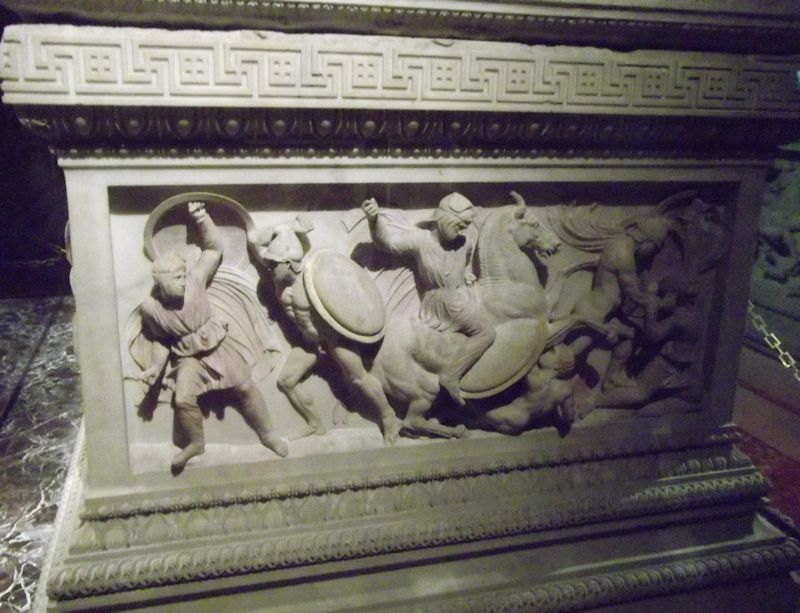
I'm not willing to believe that these people went out to fight battles wearing only a helmet on their heads. I hope that this was just an artistic convention.

-- Hey, did you hear? The old man's really dead!

-- We have nothing to discuss!

Time at last for Topkapi Palace, 20 lira each.


Kristin in the palace's harem. It's nothing like our harem at home.
After 20 lira to get into the palace, it's another 15 lira each to line up and be appalled by this monument to self-indulgence.

Harem alleyways. It's a curiously sterile tour through the harem, no attempt to bring it to life with period furniture and what not. But you get to file in line through the quarters of the Über-babe, one of the girls who managed to hang on long enough to graduate to the administrative role of running the whole place for the Sultan, sometimes with formidable political powers.
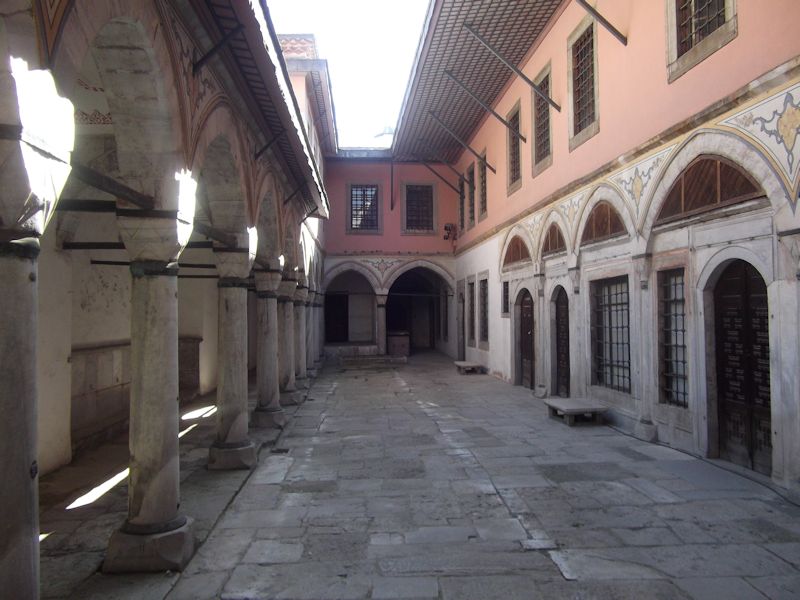
The "concubines' courtyard". Here's where the young ladies were let out to pace back and forth and exchange pleasantries. [Riker's Island]

Sultan Alphadog's Sofa Room, where he could recline on his divan and conduct business. Western European kings, for all their faults, had Throne Rooms, with real thrones, not sofas.

Imagine a lazy 18th-century afternoon here, in summer, his sultanship stretched out on his Big Sofa, all his courtiers stretched out on the little sofas, and from time to time someone saying something about foreign policy, and everybody pretending they hadn't heard him, just calling for sherbet.

The balcony above is where the ladies could sit and enjoy sherbet. Not down with the humans.

Just near this elevated porch is the lodgings of the crown prince, who was brought up within the harem and then, when he reached maturity, either succeeded his father the sultan or was killed so he wouldn't.
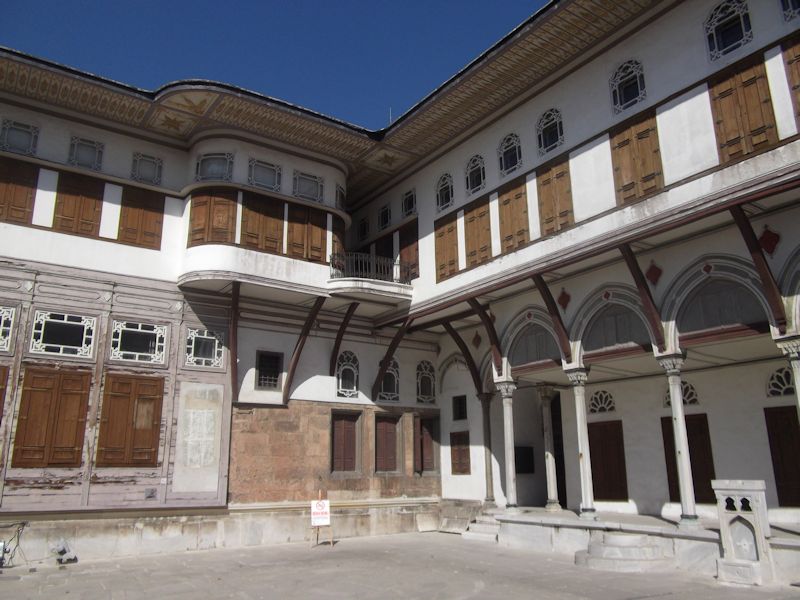
This whole place seems pretty crazy to me, as a matter of fact. A special palace within a palace to accommodate all your girlfriends. What's that all about?

Back out into the palace grounds, with a sigh of relief

We're 35 lira down already -- each -- so we're persisting. For some philistine reason, I'm starting to find this stuff laughable now (especially when I consider what the Philistines would have thought of it).

Kristin admiring a big tree with a crack in the side of it. Mohammed slept here.
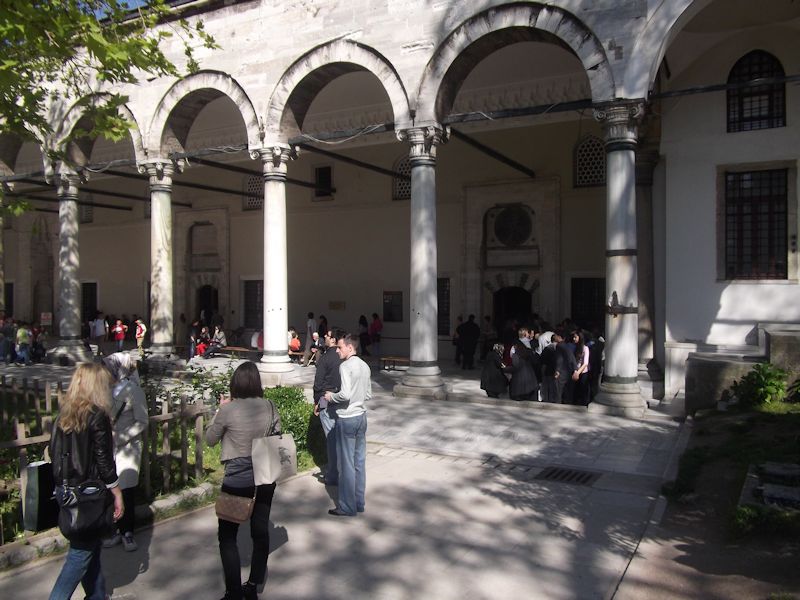
A long line at the entrance to the giant pavilion of ill-gotten treasures, gems, jewellry, that sort of thing. We beat the line by entering the second room first, thus sparing ourselves one of the four rooms of ostentatious and expensive crap. We hate people showing off their expensive jewellry.

A balcony on the palace, looking up the Bosphorus towards the Black Sea.

We're in Europe at the moment, but that's Asia on the far side.

Tour boats -- now that's worth your time. When here last, we went up the left coast there to see the Rumeli fortress, which Mehmet II built to cover himself whilst besieging Byzantium in its last days in 1453.

Great Ottoman stuff, but a little goes a long way. Maybe we can still make it to the Grand Bazaar (nope, closed on Sundays). (I didn't know they had Sundays here.)

That's me. I'm preparing, with Kristin's help, to recreate an old yellowed photograph of Marlowe in exactly this place.

Where's Marlowe? Mouseover for 1987.


"A 3-Dimensional Journey to the Depths of History." I thought we were already in the Depths of History. I think that the guy coming along with the Dustbin of History agrees with me.

More bazaars

Just strangers passing on the street. Some wearing pretzels, some not.

Vicissitudes of history

Find me a place where the US military has not got there before us.
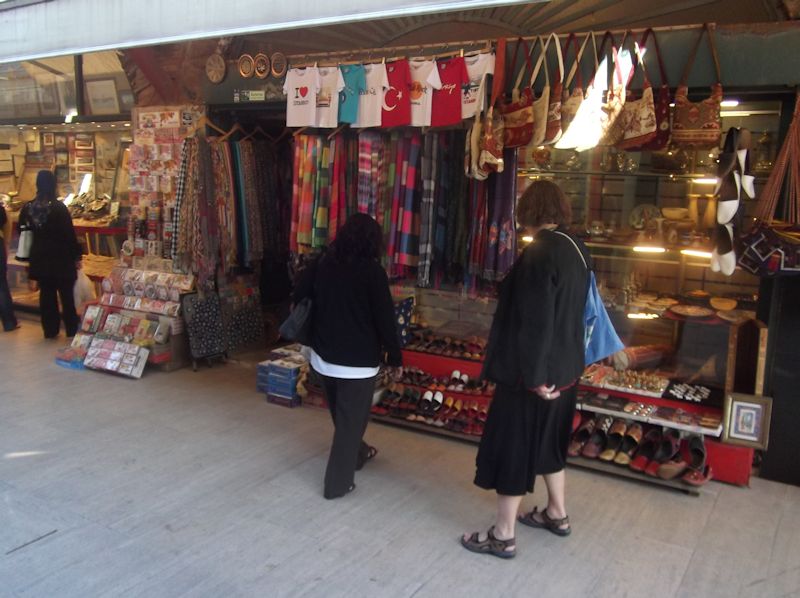
Bargains on Chinese flip-flops. Not true -- we found a very nice scarf for Kristin as a kind of putting-up-with-Ramsar present.

Not the Grand Bazaar (closed on Sundays) - a different bazaar.

Dinner in town -- an authentic Turkestan restaurant. When I asked for a beer, the waiters broke into gales of laughter and gave me a big hug.

"Now it's time for liberation of east Turkestan!" That's okay by me, I think.

Istanbul airport. Our flight's boarding, but we're trying perfumes.

And back home, surprised to be reminded that we've got a fancy new 'plasma' television set, and that the old 1984 Finlux got a new home up in the déchetterie. For about seven minutes, until the dump scavengers from France threw it into the back of a Citroën van and took it home to repair the sound on it and sell it off in Turkey.